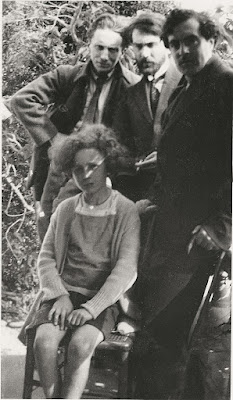BEATRIX POTTER at the VICTORIA & ALBERT MUSEUM on the 25th, April 2022
BEATRIX POTTER at the VICTORIA &
ALBERT MUSEUM on the 25th, April 2022
 |
| The Mice at work threading the needle |
Beatrix Potter was born in 1866 and lived not far from the Victoria & Albert Museum, Bolton Gardens in Kensington, London. Her parents and siblings all took to the visual arts, her father Rupert Potter (1832-1914) often photographed her as a child. Rupert Potter was a successful member of the upper-middle classes, and a practising Unitarian with unorthodox Christian beliefs. As a mid-Victorian, Potter gives us insight into attitudes to nature and ecology among the Victorian middle and upper classes.
 |
| The Tale of Benjamin Bunny |
The exhibition makes it
clear that Beatrix loved animals, we are shown a photograph of Beatrix holding
her spaniel Spot photographed by Rupert Potter in 1881. She also acquired rabbits and even squirrels,
salamanders, and bats. Beatrix and her
brother Bertram loved to dissect their animals when they died and even indulged
in taxidermy and animal anatomy. She
began to become an expert mycologist, a student of fungi, and her drawings of
mushrooms and toadstools were eventually used to illustrate academic textbooks.
 |
| Mrs Rabbit pouring tea for Peter |
When Beatrix was aged 10
her family arranged for her to have drawing and painting lessons. Her early sketchbooks, and those of her
siblings, clearly indicate a significant talent. Included in the exhibition are Beatrix’s own
watercolour set. She was also given
instruction in oils but preferred to focus on watercolours presumably because
of their quick drying and portable qualities.
 |
| The Tale of Jemimah Puddleduck |
Beatrix was also interested
in archaeology, the exhibition includes her pencil sketch of a Roman sandal
which she completed about 1900, and other excellent sketches by her of Roman
artifacts.
Beatrix Potter was
clearly very dissatisfied and frustrated at the extent of her dependency. She almost completely relied on hand outs
from her family and desperately wanted to sever the apron strings. She began to realise that the Xmas cards she
created with her drawing set and watercolours might be commercially viable and
set about publishing them for commercial sale.
This led on to her creation of anthropomorphic stories based on pets
like her rabbit Peter Piper. In 1902 she
signed a publishing deal with Frederick Warne & Co. Her books had immense appeal for young and
old. Warne projected an initial run of
8,000 copies but this quickly expanded to 28,000 by the end of the year.
 |
| Mohair toy of Jemimah Puddleduck |
Over the next decade
Warne published two of Beatrix’s books a year, there were even pirated US
editions and spin offs featuring “bad” animals like Miss Moppet the cat because Warne regarded Peter Rabbit as 'too good'.
As a child Beatrix travelled with
her family to destinations in far flung parts of England like Manchester, for her family had many
friends throughout England. In Spring
they lived in seaside resorts while their house was cleaned. Beatrix learnt to love the countryside and
eventually left London for Scotland and the Lake District.
Warne also projected
translations and international editions.
As early as 1907 Pierre le Lapin was a possible title. However, the first international edition, a Dutch edition of the tales
appeared in 1912, this being the first translation, with ‘The Story of Jemimah
Puddleduck.’
The villa at Fawe Park in
Derwentwater became a location for Beatrix’s stories and she eventually made
her home in the Lake District after her marriage to local solicitor William
Hewlis in 1913.
From then on Beatrix
worked as a breeder of Herdwick sheep and undertook conservation work on behalf
of the National Trust. Eventually the
Lake District was declared a UNESCO World Heritage Site because of her efforts
and those of the National Trust.
Paul Murphy, Victoria & Albert Museum, London, April 2022

Comments